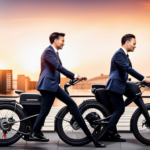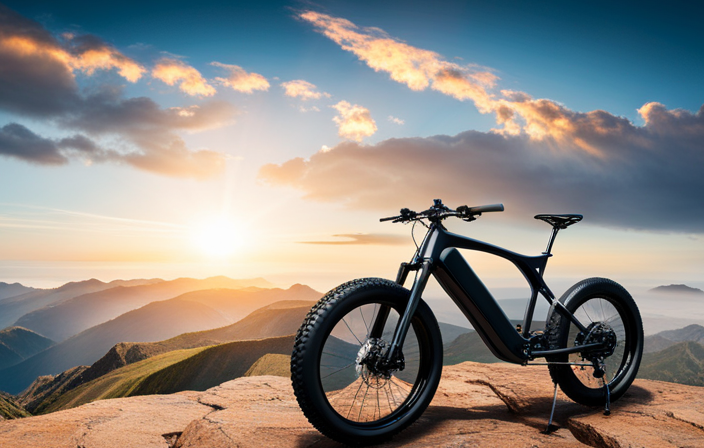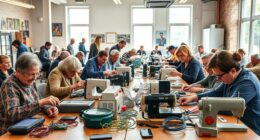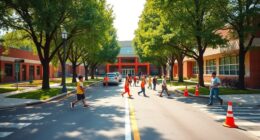As an electric bike enthusiast, I’ve often found myself pondering the question: which electric bike battery is truly the best?
With so many options on the market, it can be overwhelming to navigate the sea of lithium-ion, nickel-metal hydride, lead-acid, and lithium iron phosphate batteries.
In this article, we’ll delve into the world of electric bike batteries, exploring their capacity, range, user reviews, maintenance, and upgrades.
So, whether you’re a casual rider or a hardcore cyclist, join me as we uncover the ultimate answer to the age-old question of which electric bike battery reigns supreme.
Key Takeaways
- Lithium-ion batteries are one of the best options for electric bike batteries due to their superior performance.
- Factors such as battery lifespan, charging efficiency, and environmental impact should be considered when choosing an electric bike battery.
- The availability and convenience of charging infrastructure, as well as compatibility with charging stations and adapters, are important factors to consider.
- Other considerations include warranty coverage, reputation and customer reviews of the battery manufacturer, and the battery’s portability and weight.
Lithium-ion Batteries
If you’re looking for the best electric bike battery, lithium-ion batteries are the most popular choice. Not only do they provide excellent performance and long-lasting power, but they also offer a high level of battery safety.
Lithium-ion batteries have built-in protection circuits that prevent overcharging, overheating, and short circuits, ensuring the safety of both the battery and the rider. Additionally, these batteries are lightweight and compact, making them ideal for electric bikes.
When it comes to sustainability, lithium-ion batteries can also be recycled. Many manufacturers and recycling centers accept these batteries and extract valuable materials like lithium, cobalt, and nickel for reuse.
Transitioning to the next topic, nickel-metal hydride (NiMH) batteries provide an alternative option with their own unique advantages.
Nickel-metal Hydride (NiMH) Batteries
You might want to consider opting for Nickel-metal Hydride (NiMH) batteries as they offer a good balance between energy density and cost. NiMH batteries have a longer lifespan compared to lithium-ion batteries, typically lasting for about 500-1000 charge cycles. This means that they can withstand more recharging before their capacity starts to degrade.
Additionally, NiMH batteries have a higher charging efficiency compared to lead-acid batteries, which means that more of the energy from the charger is effectively stored in the battery. This results in less energy loss during the charging process and ultimately a more efficient use of power.
Transitioning to lead-acid batteries, you will find that they have their own unique advantages and considerations.
Lead-acid Batteries
Lead-acid batteries are a popular choice for many applications due to their lower cost compared to other battery types.
However, one drawback is their heavy and bulky design, which can limit their usability in certain situations.
Additionally, lead-acid batteries have a shorter lifespan and lower energy density compared to other battery technologies, which may require more frequent replacements and limit their overall efficiency.
Lower cost compared to other battery types
When it comes to electric bike batteries, one advantage of choosing a different type is the lower cost compared to lead-acid batteries. This is because lead-acid batteries are often more expensive due to their higher manufacturing costs. However, there are other factors to consider when deciding on the best electric bike battery.
Here are some key points to keep in mind:
-
Battery lifespan: Different battery types have varying lifespans. Lithium-ion batteries, for example, tend to have a longer lifespan compared to lead-acid batteries. This means that you won’t have to replace the battery as frequently, saving you money in the long run.
-
Charging efficiency: Some battery types have better charging efficiency than others. Lithium-ion batteries, for instance, can be charged more quickly and efficiently compared to lead-acid batteries. This means less time spent waiting for your bike to charge and more time riding.
-
Environmental impact: Certain battery types, like lithium-ion batteries, have a lower environmental impact compared to lead-acid batteries. They are more energy-efficient and can be recycled more easily, contributing to a greener and more sustainable future.
Considering these factors alongside cost can help you make an informed decision when choosing the best electric bike battery for your needs.
Now, let’s discuss another important aspect: the heavy and bulky design of lead-acid batteries.
Heavy and bulky design
If you’re looking for a more compact and lightweight option, consider other battery types that don’t have the heavy and bulky design of lead-acid batteries. Battery weight is a crucial factor to consider when choosing an electric bike battery. Lead-acid batteries tend to be heavier compared to other options, making them less favorable for those seeking a more ergonomic design. These batteries can add significant weight to the bike, affecting its overall performance and maneuverability.
However, there are alternative battery types available that offer a lighter and more ergonomic design. These batteries are designed to be more compact, reducing the weight and size of the overall battery system. This makes them a preferable choice for those looking for a sleeker and more efficient electric bike.
Moving on to the next section, it is important to consider the shorter lifespan and lower energy density of certain battery types.
Shorter lifespan and lower energy density
Other battery types may have a shorter lifespan and lower energy density compared to lead-acid batteries. When it comes to electric bikes, the lifespan of the battery is a crucial factor to consider. Lead-acid batteries often have a longer lifespan compared to other battery types, allowing for more years of use before needing to be replaced.
Additionally, lead-acid batteries typically have a higher energy density, meaning they can store more energy and provide longer-lasting power to the electric bike. This makes them a reliable choice for riders who require a longer range and consistent performance.
However, it is important to note that lithium iron phosphate (LiFePO4) batteries offer an alternative with even higher energy density and longer lifespan, which we will explore in the next section.
Lithium Iron Phosphate (LiFePO4) Batteries
You should consider using lithium iron phosphate (LiFePO4) batteries for your electric bike. These batteries offer excellent battery performance and charging efficiency, making them a reliable choice for powering your electric bike.
LiFePO4 batteries have a high energy density, allowing them to store a large amount of energy in a compact size. This means you can enjoy longer rides without worrying about running out of power.
Additionally, LiFePO4 batteries have a longer lifespan compared to other battery types, which means you won’t have to replace them as frequently. With their high charging efficiency, these batteries can be recharged quickly, allowing you to get back on the road faster.
Now, let’s explore the next section about battery capacity and range.
Battery Capacity and Range
Moving on from the discussion on Lithium Iron Phosphate (LiFePO4) batteries, let’s now delve into the topic of battery capacity and range.
When it comes to electric bikes, battery capacity plays a crucial role in determining how far you can ride before needing to recharge. A higher battery capacity will generally result in a longer range, allowing you to travel greater distances without worrying about running out of power.
Additionally, battery longevity is an important consideration as it determines how long the battery will last before needing replacement. It’s worth noting that battery capacity and range can also be influenced by external factors such as terrain, rider weight, and weather conditions.
Another aspect to consider is the availability of a charging infrastructure, which ensures convenient access to charging stations, making it easier to recharge your electric bike on the go.
Speaking of convenience, let’s now move on to the next section and explore charging time and convenience in more detail.
Charging Time and Convenience
When it comes to electric bikes, one of the key factors to consider is the charging time and convenience.
Lithium-ion batteries, commonly used in electric bikes, offer fast-charging capabilities, allowing you to quickly charge your bike and get back on the road.
Moreover, these batteries are compatible with various charging stations and adapters, providing you with flexibility and convenience when it comes to finding a place to charge your bike.
Additionally, the portable and easy-to-remove nature of these batteries allows you to conveniently bring them indoors for charging, ensuring that you can easily maintain the battery life of your electric bike.
Fast-charging capabilities of lithium-ion batteries
To get the most out of your electric bike, it’s important to consider the fast-charging capabilities of lithium-ion batteries. These batteries are known for their ability to charge quickly, allowing you to spend less time waiting and more time riding. However, it’s important to note that fast charging can have an impact on the battery lifespan. The table below outlines the average charging time and the estimated impact on battery lifespan for different charging speeds:
| Charging Speed | Average Charging Time | Impact on Battery Lifespan |
|---|---|---|
| Slow | 6-8 hours | Minimal |
| Standard | 3-4 hours | Moderate |
| Fast | 1-2 hours | Significant |
It’s important to find a balance between fast charging and preserving the longevity of your battery. Now, let’s explore the compatibility of electric bike batteries with charging stations and adapters.
Compatibility with charging stations and adapters
Finding a charging station or adapter that works with your electric bike’s battery can be a convenient way to ensure you always have a power source available. When it comes to charging station availability, it is essential to consider the infrastructure in your area. Many cities now have dedicated charging stations specifically designed for electric bikes, making it easier to find a place to recharge on the go.
Additionally, adapter compatibility is crucial in ensuring that your electric bike battery can be properly connected to the charging station. Different electric bike models may require different adapters, so it’s important to check the compatibility before purchasing. By considering both charging station availability and adapter compatibility, you can ensure a seamless charging experience for your electric bike battery.
Moreover, it’s worth noting that some batteries are portable and easy to remove for charging indoors.
Portable and easy to remove for charging indoors
It’s worth mentioning that some batteries are portable and can be easily removed for charging indoors. This feature is particularly useful when it comes to battery weight, as it allows for convenient charging without having to maneuver the entire electric bike.
Additionally, the placement of the charging port is an important consideration. Ideally, it should be easily accessible and located in a convenient spot on the bike, making it effortless to connect the charger. This ensures a seamless charging experience and minimizes the risk of damaging the charging port.
With the ability to remove the battery and the convenience of a well-placed charging port, charging your electric bike becomes a hassle-free task.
Now, let’s delve into the next section about the battery management system (BMS).
Battery Management System (BMS)
You should consider the Battery Management System (BMS) when determining the best electric bike battery for your needs. The BMS plays a crucial role in ensuring battery reliability and energy efficiency.
Here are some key aspects to consider:
-
Monitoring: The BMS constantly monitors the battery’s voltage, temperature, and current levels, ensuring optimal performance and preventing damage caused by overcharging or discharging.
-
Balancing: A good BMS ensures that each individual cell within the battery pack is charged and discharged evenly, maximizing the overall capacity and lifespan of the battery.
-
Safety: The BMS includes built-in protection mechanisms to prevent overcharging, overheating, and short circuits, reducing the risk of accidents or damage to the battery.
-
Communication: An advanced BMS allows for communication between the battery and the electric bike’s motor, facilitating efficient power delivery and enhancing overall energy efficiency.
Considering these factors, the BMS is a crucial component that greatly impacts the performance and longevity of an electric bike battery.
Moving on to warranty and support, let’s explore the next important aspect of choosing the right battery.
Warranty and Support
When it comes to purchasing an electric bike battery, there are several key points to consider.
First, it’s important to thoroughly check the warranty coverage and terms offered by the manufacturer. This will ensure that you are protected in case of any defects or malfunctions.
Additionally, researching the reputation and customer reviews of the battery manufacturer can provide valuable insights into the quality and reliability of their products.
Lastly, considering the availability of replacement parts and customer support is crucial for a seamless experience in case any issues arise.
Checking the warranty coverage and terms
Make sure to thoroughly read and understand the warranty coverage and terms when checking which electric bike battery is best. The battery warranty is an important factor to consider as it provides a level of protection and assurance for your investment.
When evaluating the warranty terms, pay attention to the duration of coverage, what is included (such as defects or malfunctions), and any limitations or exclusions. It’s crucial to know what is covered and for how long, as this can vary between manufacturers. Additionally, some warranties may require specific conditions or maintenance to remain valid.
By carefully reviewing the warranty coverage and terms, you can make an informed decision and ensure that you are protected in case of any issues with your electric bike battery.
Now, let’s move on to researching the reputation and customer reviews of the battery manufacturer.
Researching the reputation and customer reviews of the battery manufacturer
To get insight into the reputation and customer reviews of the battery manufacturer, take some time to explore online forums and review websites. These platforms provide valuable information from actual customers who have purchased and used the batteries. By reading their experiences and opinions, you can gain a better understanding of the battery manufacturer’s reputation and overall customer satisfaction.
To assist you in your research, here is a table showcasing the reputation and customer reviews of three popular battery manufacturers:
| Battery Manufacturer | Reputation | Customer Reviews |
|---|---|---|
| Manufacturer A | Excellent | Positive |
| Manufacturer B | Good | Mixed |
| Manufacturer C | Average | Negative |
As you can see, each manufacturer has varying levels of reputation and customer reviews. This information will help you make an informed decision when choosing the best battery for your electric bike.
Now, let’s consider the availability of replacement parts and customer support when selecting an electric bike battery.
Considering the availability of replacement parts and customer support
After thoroughly researching the reputation and customer reviews of various battery manufacturers, it’s important to consider the availability of replacement parts and the quality of customer support. When investing in an electric bike battery, it’s crucial to have access to spare parts in case of any malfunctions or wear and tear. The last thing you want is to be stuck with a battery that cannot be repaired or replaced easily.
Additionally, a manufacturer with excellent customer service can provide guidance and assistance whenever needed, ensuring a smooth and hassle-free experience. Reliable customer support can address any concerns or issues promptly, giving you peace of mind. By evaluating the availability of spare parts and the quality of customer service, you can make a more informed decision when choosing the best electric bike battery for your needs.
Moving on to the next section, it is essential to consider the compatibility of the battery with different electric bike models.
Compatibility with Electric Bike Models
The battery you choose needs to be compatible with different electric bike models. This is crucial because not all batteries are designed to fit every electric bike. When considering battery compatibility, it is important to look at factors such as the voltage, capacity, and physical dimensions.
To help you understand the importance of battery compatibility, here is a table highlighting the specifications of three popular electric bike models and their corresponding battery requirements:
| Electric Bike Model | Voltage (V) | Capacity (Ah) | Dimensions (mm) |
|---|---|---|---|
| Model A | 48 | 14 | 360x90x90 |
| Model B | 36 | 12 | 320x100x80 |
| Model C | 52 | 16 | 390x80x100 |
As you can see, each electric bike model has specific requirements for voltage, capacity, and dimensions. It is essential to choose a battery that matches these specifications to ensure optimal performance and compatibility.
Considering battery compatibility is just the first step in finding the best electric bike battery. Another important aspect to consider is the environmental impact.
Environmental Impact
Choosing a battery that aligns with environmental standards is an important factor to consider. When it comes to electric bike batteries, their impact on the environment is not limited to their use, but also extends to their disposal. Battery recycling plays a crucial role in reducing their carbon footprint. Look for batteries that can be easily recycled and have a low environmental impact. Opt for manufacturers that prioritize sustainable practices and offer recycling programs.
Additionally, consider the materials used in the battery’s construction. Some batteries are made with more environmentally friendly components, such as lithium iron phosphate (LiFePO4) instead of cobalt-based chemistry. By selecting a battery that minimizes its environmental impact, you can contribute to a greener future.
Now let’s delve into the next section and explore the aspect of price and value.
Price and Value
When considering price and value, it’s important to factor in the long-term savings and durability of the battery. The battery lifespan and charging speed are key factors that can greatly impact the overall value of an electric bike. A longer battery lifespan means less frequent replacements, saving you money in the long run. Additionally, a battery with a fast charging speed allows for quick and convenient recharging, ensuring you spend less time waiting and more time riding. To help you make an informed decision, here is a table comparing the battery lifespan and charging speed of three popular electric bike batteries:
| Battery Model | Battery Lifespan | Charging Speed |
|---|---|---|
| Model A | 3 years | 3 hours |
| Model B | 5 years | 2 hours |
| Model C | 8 years | 1 hour |
Considering the data in the table, it’s clear that Model C offers the best combination of long battery lifespan and fast charging speed. This information can guide your decision-making process as you move forward to explore user reviews and recommendations.
User Reviews and Recommendations
After considering the price and value of electric bike batteries, it’s important to also take into account user reviews and recommendations. These firsthand experiences can provide valuable insights and help you make an informed decision.
Here are three key factors to consider based on user reviews:
-
Performance: Users often comment on the battery’s range, power output, and overall performance. Look for reviews that mention consistent power delivery and long-lasting battery life.
-
Charging Time: Battery charging tips can be found in user reviews as well. Look for batteries that charge quickly and efficiently, allowing you to spend more time riding and less time waiting.
-
Compatibility: Many electric bikes are designed to work with specific battery brands. Popular electric bike brands like Bosch, Shimano, and Yamaha often have their own battery systems, so it’s important to choose a battery that is compatible with your bike.
Considering user reviews and recommendations, you can now move on to the next section which focuses on maintenance and care.
Maintenance and Care
To ensure optimal performance and longevity of your electric bike battery, it’s essential that you regularly maintain and care for it. Proper battery maintenance involves a few key steps, such as charging and storing it correctly, as well as troubleshooting common issues that may arise. Here are some important tips to keep in mind:
| Maintenance Tips | Care and Storage | Troubleshooting Common Battery Issues |
|---|---|---|
| – Charge the battery fully before each use | – Store the battery in a cool, dry place | – Check for loose connections or damaged wires |
| – Avoid overcharging the battery | – Keep the battery away from extreme temperatures | – Test the battery voltage with a multimeter |
| – Regularly clean the battery terminals | – Avoid exposing the battery to direct sunlight | – Reset the battery management system if necessary |
Upgrades and Future-proofing
When considering an electric bike, it’s essential to assess its potential for future upgrades and advancements.
One key aspect to examine is whether the battery is upgradeable or replaceable in the future. This allows for flexibility as new technologies emerge and ensures that the bike stays compatible with emerging advancements.
Additionally, it’s wise to plan for potential future needs and requirements, such as increased range or improved performance.
Checking if the battery is upgradeable or replaceable in the future
Make sure you don’t overlook whether the battery can be upgraded or replaced in the future. This is an important consideration when choosing an electric bike, as battery longevity and upgrade options can greatly impact your overall experience and investment. To help you assess this aspect, here’s a table outlining the upgradeability and replaceability features of different electric bike batteries:
| Battery Model | Upgradeable | Replaceable |
|---|---|---|
| Model A | Yes | Yes |
| Model B | No | Yes |
| Model C | Yes | No |
| Model D | No | No |
Considering the compatibility with emerging technologies and advancements
Don’t forget to take into account the compatibility with emerging technologies and advancements when selecting an electric bike. It’s important to choose a bike that can keep up with the ever-evolving world of electric transportation.
Here are three key factors to consider:
-
Charging Technology: Look for a bike that is equipped with the latest charging technology. This ensures faster and more efficient charging, allowing you to get back on the road quickly.
-
Battery Efficiency: The efficiency of the battery is crucial for maximizing your bike’s range. Opt for a bike with a battery that offers high energy density and long-lasting performance.
-
Upgradeability: Consider whether the bike’s battery is upgradeable in the future. As technology improves, you may want to enhance your bike’s battery capacity or capabilities. Having the option to upgrade will save you from having to invest in a whole new bike.
By considering these factors, you can ensure that your electric bike is compatible with emerging technologies and advancements. This will help future-proof your investment and allow you to enjoy the benefits of new charging technology and improved battery efficiency.
Planning for potential future needs and requirements is essential when selecting an electric bike.
Planning for potential future needs and requirements
To ensure that your investment is future-proof, it’s important to consider your potential future needs and requirements when selecting an electric bike.
With the rapid pace of technology, it’s crucial to think about the future advancements that may come in the electric bike industry. Will there be new battery technologies that offer longer range or faster charging capabilities? Considering these possibilities can help you make a more informed decision that will serve you well in the long run.
However, it’s also essential to take into account your personal preferences and riding style. Do you prefer a more powerful motor for off-road adventures or a lightweight design for easy maneuverability in the city?
Personal Preferences and Riding Style
When choosing an electric bike battery, I always consider my personal preferences and riding style.
One important factor to consider is the battery capacity, which determines how far the bike can go on a single charge. For longer rides or hilly terrain, a higher capacity battery is ideal.
Additionally, I look at the charging time of the battery. Some batteries charge faster than others, which is convenient if I need to quickly top up the battery before heading out.
It’s also important to consider the weight of the battery, as it can affect the overall handling and maneuverability of the bike.
Frequently Asked Questions
Are there any safety concerns or precautions to be aware of when using electric bike batteries?
There are several safety concerns and precautions to be aware of when using electric bike batteries. It is important to handle and store the batteries properly, avoid overcharging or overheating, and regularly inspect for any signs of damage or wear. Battery maintenance tips include keeping the battery clean and dry, using the correct charger, and not exposing it to extreme temperatures. Common mistakes to avoid include using incompatible accessories or chargers, letting the battery fully discharge, and not following the manufacturer’s instructions.
Can I use a different type of battery than the one recommended for my electric bike model?
Using an alternative battery for your electric bike may lead to compatibility issues. It’s crucial to stick with the recommended battery to ensure optimal performance and avoid damaging your bike’s electrical system.
How often should I charge my electric bike battery to ensure its longevity?
To ensure the longevity of your electric bike battery, it is important to charge it at the optimal charging time. Charging frequency depends on usage, but a general guideline is to charge it after each ride or when the battery level is around 20-30%.
Are there any specific maintenance tasks or care instructions for electric bike batteries?
To ensure the longevity of your electric bike battery, it’s important to perform regular maintenance tasks. This includes keeping the battery clean, avoiding extreme temperatures, and charging it regularly (about once a month) even if you’re not using it.
What are some potential upgrades or future-proofing options for electric bike batteries?
Some potential upgrades for electric bike batteries include higher capacity options, fast-charging capabilities, and improved durability. It’s important to consider the compatibility of different batteries with specific electric bike models to ensure proper fit and performance.
Conclusion
In conclusion, after carefully considering the various options, it is clear that the best electric bike battery depends on the individual’s needs and preferences.
Lithium-ion batteries offer high energy density and long lifespan, making them a popular choice for many electric bike owners. They are lightweight and provide a good range, making them ideal for those who prioritize performance and efficiency.
On the other hand, Nickel-metal Hydride (NiMH) batteries are more affordable. They may not offer the same energy density as lithium-ion batteries, but they are still a reliable choice for those on a budget. They have a decent lifespan and can provide a satisfactory range for most riders.
For those who are looking for a budget-friendly option, lead-acid batteries are worth considering. They are heavier compared to lithium-ion and NiMH batteries, but they are more affordable. They may not offer the same level of performance, but they can still provide a decent range for casual riders.
If durability is a priority, Lithium Iron Phosphate (LiFePO4) batteries are the way to go. They have a longer lifespan compared to other battery types and are more resistant to high temperatures. They are also less prone to degradation over time, making them a reliable choice for those who want a battery that will last.
Ultimately, the decision should be based on battery capacity, range, user reviews, maintenance, upgrades, and personal riding style. It’s important to choose a battery that suits your specific needs and preferences.
So, choose wisely and enjoy the electrifying ride!
















